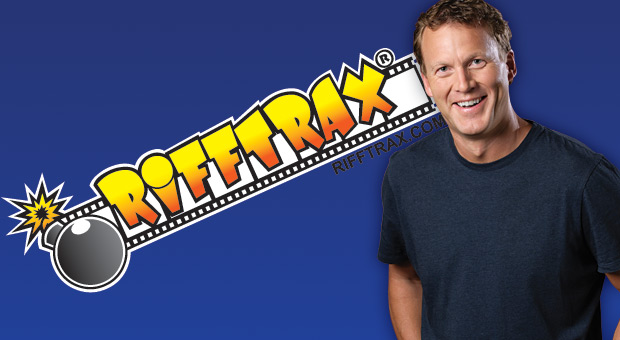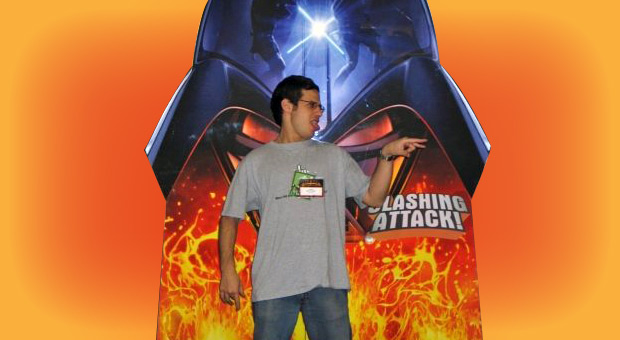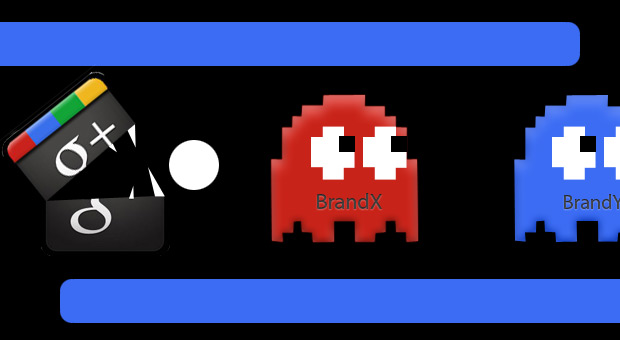Mike Nelson is a hero to those who love (or love to hate) bad movies. Having served as head writer and host of the classic TV series Mystery Science Theater 3000, Nelson played a large role in elevating movie riffing into a new form of comedy. After the show ceased production in 1999, he kept […]
Mike Nelson is a hero to those who love (or love to hate) bad movies. Having served as head writer and host of the classic TV series Mystery Science Theater 3000, Nelson played a large role in elevating movie riffing into a new form of comedy. After the show ceased production in 1999, he kept the flame alive with various projects, but most significantly with the 2006 launch of RiffTrax. An innovative site where users download audio commentaries and sync them with DVDs and Blu-rays, RiffTrax – which features Nelson and fellow MST3K stars Kevin Murphy and Bill Corbett – lampoons everything from Michael Bay’s Transformers to classics like Casablanca to oddities like Santa and the Ice Cream Bunny. RiffTrax has also produced a series of successful live shows that are simulcast to movie theaters nationwide, with the latest installment set for August 17: a riffing of the low-grade 1962 fantasy adventure, Jack the Giant Killer. We recently spoke with Nelson about taking a chance on Twilight, sending the Tweet that may have started an Internet forest fire, and blowing up a cheese factory.
Flightpath: I know that after MST3K, you started doing some commentaries for Legend Films on DVD releases like Plan 9 From Outer Space and Little Shop of Horrors, and that led to RiffTrax. But when did the idea of “let’s record commentaries on MP3s and have users sync them with their DVDs” actually hatch?
Mike Nelson: It was actually quite awhile ago. I think probably the first time we ever did some specials for MST, we got to use modern movies because we were just taking bits of the EPK and using that. People were like, “Why aren’t you guys doing this,” which is fairly obvious, why we weren’t. We were thinking in the old days about bundling DVDs with the commentary, kind of before MP3s really took over. So it had been brewing for awhile.
Flightpath: I find that part of the charm of RiffTrax is the syncing. It gives it kind of an underground feel and adds to the experience.
Mike Nelson: You know, we sort of tentatively launched it. We knew that there was at least some demand, because I would get emails. A lot of people saying, “Why aren’t you doing this? This idea is so obvious, you should do this!” And so I knew that there were at least some people who were interested in it, but people say a lot of things. We get suggestions for movies, and people are like, “This would be killer, we would love this,” and then nobody buys it because it’s just a little too off the beaten path. So this seems like it could’ve taken that route, but like you say, there’s a savviness to people who like to be early adopters, and there’s something fun about it.
Flightpath: With RiffTrax, you can do anything because you’re only offering the audio files. Was that really freeing for you compared to MST3K, where your scope was more limited?
Mike Nelson: Yeah, and time limits [on MST3K] were kind of frustrating. Not always, because sometimes you could edit a film and make it actually better than the filmmakers did [Laughs], so you could leave out all the dull parts. But a little bit restricting when you were cutting a lot of stuff that was funny. And that was frustrating for us because we’d write the movie first before we’d edit it, because we just didn’t know how much time we could have. And you’d have to cut a favorite passage because if you didn’t include another part that you needed for the plot…it just presented a lot of complications. So to just be able to do the movie, is sort of freeing.
Flightpath: I wanted to know if I could go through a few RiffTrax with you, and you could give your thoughts on the movie itself and how you attacked it.
Mike Nelson: Sure.
Flightpath: Okay, Birdemic?
Mike Nelson: [Laughs] Well, it’s one of those things we’ve been talking about a lot lately, because a couple of people have emailed and said, “Why did you make me sit through that?” And I think they meant it sincerely. [Laughs] A lot of times people are kidding. It’s one of those things where it’s like, it’s totally indefensible that I like it, because generally, despite what I do for a living, I like to champion good things. But there’s this fun side that’s undeniable, and sometimes things that are totally inexplicable make you laugh. And again, this is one of those where I find it absolutely delightful. And yet if you go, “That is the worst thing. Banish it to the deepest pits of Hell,” I’d be hard pressed to disagree with you.
Flightpath: Twilight?
Mike Nelson: Twilight was very risky for us. In fact, I had a bet with the CEO of Legend, who we partner with. He said, “No, it’s a girl movie. It’s not our audience at all. It’s a bad idea and it’s a risk.” So I bet him a sushi lunch that it would be a success. And it was one of our biggest ones, and it was really, really fun once we weighed it in, because obviously none of the people who work at Legend would be watching these movies or know anything about them. So screening it was a delight, because we were like, “Wow, this is the movie we’ve been waiting for.” [Laughs]
Flightpath: I just felt that with its long dramatic pauses and how serious it took itself, it was perfect for you guys.
Mike Nelson: Yeah, we always are laying out the criteria. We say it has to be sincere, and you know, the pauses – that’s just sort of a technical thing, you have to have room to say something – and it has to have goofy elements. And, boy oh boy, does it excel at all of those things.
Flightpath: The Room?
Mike Nelson: That was also a risky one. We had heard the rumblings about this being the “new B-movie.” There’s something about these really bad movies that you have to know the story going in. You have to know, is this sincere? Is this a put-on? Because how do you relax and enjoy how bad it is when you’re sitting there going, “What is this? Who made this?” And that was my concern about it, that it was just too weird. But then like, two viewings of it convinced me. Once you sort of see the disjointed logic and everything, and you get the story of it, it really helps, and that made it enjoyable. And it was successful for us. But again, another movie like Birdemic, that stands on its own, but we think is enhanced by us.
Flightpath: And you met [The Room director and star] Tommy Wiseau?
Mike Nelson: I didn’t meet him face-to-face. We had several discussions with him; he was concerned about our RiffTrax, and he called us up. I think he really thought that we were stealing his movie or something. I don’t think he fully understood what we were saying, that it was just a commentary to it. But he – for a long time – tried to talk us into settling a lawsuit that he was going to bring, and I think we just couldn’t get through to him.
But then after that, coincidentally, he was at Comic-Con, and my son who had seen The Room went and waited in line for him and got pictures with him and with [Greg Sestero, who plays Mark in The Room], and he mentioned who he was. And again, Wiseau seemed confused, but [Greg] was like, “Oh yeah, I heard about this. I heard it’s really funny!” And he’s since admitted that he loves it. So at least somebody knows and understands the spirit of it and thinks it’s funny.
Flightpath: The Internet has evolved into a real destination for comedy, from Funny or Die to College Humor to RiffTrax. Why do you think that is?
Mike Nelson: I think [it’s] immediate access to things that you really like without the filter. You can pick or choose what or when or where. Now that that’s becoming just totally ingrained, I just don’t see that changing. I don’t see the tides of that changing, especially with Hulu and all of that. It just makes no sense. The gatekeepers, I think they’re in trouble as far as that goes, because you can make something and give it directly to the people who want to have it for exactly the kind of arrangements you want to make on it.
I love it. I mean, obviously RiffTrax couldn’t be possible without that, and just connecting on that level and reacting to what people want to see very quickly, I think makes it exciting.
Flightpath: Kind of an extension of that is Twitter, which has drawn a lot of comedy writers and comedians, and you got on board pretty early. What do you think of Twitter?
Mike Nelson: I like it. My use for it is fairly limited. People like me to crack wise about stuff, and that’s pretty much what I use it for: mostly jokes, a few advertisements about what we’re doing – which I never feel bad about, because I’m talking to the very audience who presumably likes what I have. I just try to make it a nice balance of very light stuff and things of interest, pointing things out to people and jokes, and then a few bulletins about what we’ve got going on. It works for me, and then all the people that I think are funny or want to pay attention to, I do the same. It’s perfect.
I know from the outside, when I first was looking into Twitter, I just didn’t understand. “Why? Who would do this?” You have to maybe spend a couple of hours actually doing Twitter and reading what’s going on, and then you get it. “Oh, okay, I understand how these little bulletins work.”
Flightpath: I’d imagine it’s also kind of a good comedy workout, in that you have 140 characters to say what’s in your head perfectly and funny.
Mike Nelson: Yeah. It’s very similar to what we do with RiffTrax, because you get this setup and you get this amount of space to say it in. So we’ve been well-practiced at that. I did a book once [in the Pop Ink series with the Charles S. Anderson Design Company]; it was graphics mostly, but they wanted commentary on it. When I collaborated with them, they would send me the pages back and say, “You need to trim three letters from this.” [Laughs] You know, it became so unbelievably technical. But I had been trained for like, “Okay, make it three letters shorter. How do you reword it to make it fit?” I kind of like the challenge of that.
Flightpath: Did you send the Tweet that basically created Rebecca Black? Is that true?
Mike Nelson: I have been credited for that. We were watching that over the weekend that that happened, and it did sort of fan out from my Tweet about it. Usually just by sheer scale on Twitter, when you post something and you get the replies, you’re kind of like, “Okay, I got 30 or 40 or whatever, that’s fairly decent,” – direct replies or ReTweets or whatever – and this one was just like, insane. Just so many people responding, and it just went on and on. I happened to be traveling that weekend, so I was sort of paying half an eye to it. But another writer here, Conor Lastowka, was Tweeting me, “Uh, we’re up to however many million, and it’s climbing.” So that was kind of fun to watch. It did seem to fan out from there. And obviously you never know for sure. It’s like the forest fire thing. It’s really hard to know what was the thing that started it all.
Flightpath: How do you compare writing for RiffTrax, which is released quickly and online – people can get it instantly – with writing for other mediums you’ve worked in, like TV and print?
Mike Nelson: I just consider the writing of RiffTrax a hard slog at times, because you’re concentrating so much that the amount of time that it takes would probably surprise people, and probably be pretty daunting to most writers. But once you get the efficiencies of it, and you understand what you’re doing – and obviously we’ve done this a lot – there’s something very nice about relaxing into that. It’s like, some people just like doing manual labor to think. This is kind of the opposite. It gets you away from all of the other writing. You know, writing is hard, and I always try to avoid it. Even though I do it for a living, and I’m constantly writing.
When I hear people say, “Oh, when I just have some downtime, I just love to do some writing,” I’m like, “Really? Are you insane? It’s really, really hard!” But there is an element of relaxation to doing it for RiffTrax, where you know what you have ahead of you and it looks like a lot of work. It’s kind of like when I was a kid, I used to like when my dad would to tell me to move a big stack of wood. It was just like, “Well, you know, you just have to do it.” And there’s something about that, of just having this large task ahead of you, and just putting your head down and doing it.
Flightpath: RiffTrax is going back to movie theaters with a new live event. What can you tell us about the movie that you’re going to be riffing and the live experience?
Mike Nelson: Live is always exciting for us, because rarely do we get the immediate feedback. Like I said, you’re sitting in a room doing the slog of writing, and then when we get together amongst ourselves it’s always fun to sort of refine the script. That’s got a writing room feel to it. But you’re still not interacting with an audience, and so that’s always a blast, and the feeling of the infectiousness of laughs is just good for the soul.
The movie that we have is sort of a lift for us, because in the past we were sort of limited to public domain movies, and we’ve worked a lot of the best ones. Titles that could be recognized by an audience and get people excited, we’ve already done. And so this being a brand new one is pretty exciting for us. It’s Jack the Giant Killer, which is kind of a Sinbad adventure-style movie, with stop-animation giants, and wizards and witches and leprechauns in jars, and stuff like that. So it’s pretty perfect for us. It’s not quite an A-level version of that movie; it’s definitely in the B camp.
Flightpath: I have one last question. This is one thing I’ve always wondered. How close was the actual young Mike Nelson in real life compared to the one seen in the MST3K episode Time Chasers, who had hockey hair, temped in a cheese factory, and was in a band called Sex Factory?
Mike Nelson: [Laughs] It wasn’t very close. The cheese factory simulation was spot on, but I was basically playing guys that I had worked with at the cheese factory. I was the odd man out there and looked on as kind of strange, but yeah, through college I worked nights at a cheese factory. It was like 12 to 14 hour days, and I just did it because it was a job that was close. About a couple of years into it I realized that everyone I was working with had been making like five times as much as me, because it was the most hated job in the world and no one would do it. I was like, making minimum wage, putting in 14 hours a night. Stories of the cheese factory never ended in the writing room, and finally the guys were like, “Can we just do an episode about this?”
Flightpath: Well, I’m glad you got out.
Mike Nelson: [Laughs] I did, I did. My fantasy was that I’d make it big in Hollywood, and I would buy the cheese factory, I’d pay off all the workers, have a huge party, and we’d blow up the factory. That’s every guy’s dream when you have a bad job.


 Users are directed to the application, which is hosted on the
Users are directed to the application, which is hosted on the  According to
According to 


 I’m psyched that we introduced augmented reality to it. I think [Falcon Gunner] is closer in spirit to the original arcade game than any of the others. It’s more arcadey, and really, the design objective was really simple.
I’m psyched that we introduced augmented reality to it. I think [Falcon Gunner] is closer in spirit to the original arcade game than any of the others. It’s more arcadey, and really, the design objective was really simple.